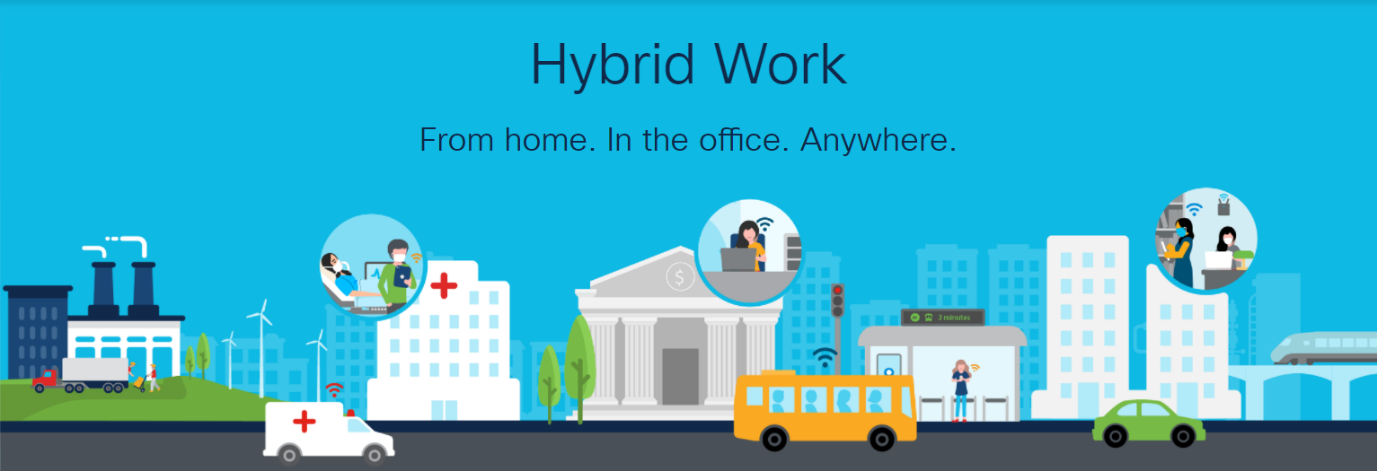ประเด็นข่าว:
-
- ดัชนีใหม่จากซิสโก้อ้างอิงข้อมูลลูกค้าที่ไม่ระบุชื่อหลายล้านรายการ เผยข้อมูลเชิงลึกเกี่ยวกับพฤติกรรม ความต้องการ และการใช้เทคโนโลยีในยุคการทำงานแบบไฮบริด
- การใช้ AI เติบโตกว่า 200% บ่งชี้ว่าผู้ใช้ต้องการประสบการณ์การประชุมที่ปรับปรุงให้ดีขึ้น
- การประชุมผ่านอุปกรณ์มือถือขณะเดินทางเพิ่มขึ้น 300% ในช่วงการแพร่ระบาด
- การรักษาความปลอดภัยยังคงมีความสำคัญอย่างมาก เนื่องจากเดือนกันยายน 2564 เพียงแค่เดือนเดียว พนักงานที่ทำงานแบบไฮบริดตกเป็นเป้าหมายการโจมตีของภัยคุกคามทางอีเมลกว่า 100 ล้านครั้งต่อวัน
ซิสโก้ (NASDAQ: CSCO) เปิดตัวรายงานผลการศึกษาดัชนีการทำงานแบบไฮบริดทั่วโลก (Hybrid Work Index – HWI) เป็นครั้งแรก โดยอ้างอิงข้อมูลลูกค้าแบบรวมที่ไม่ระบุชื่อหลายล้านรายการ ดัชนีดังกล่าวได้รับการอัพเดตทุกไตรมาส โดยศึกษาพฤติกรรม และรูปแบบการใช้งานเทคโนโลยี ซึ่งรายงานชี้ให้เห็นความเปลี่ยนแปลงอย่างชัดเจนต่อรูปแบบการทำงานในช่วงหนึ่งปีครึ่งที่เกิดการแพร่ระบาดของโควิด-19 ผลการสำรวจแสดงให้เห็นว่าบุคลากรที่ทำงานในรูปแบบไฮบริดคาดหวังว่าจะมีการปรับปรุงด้านความยืดหยุ่นในการทำงาน การเข้าถึงระบบ และความปลอดภัย ขณะที่องค์กรธุรกิจพยายามตอบสนองความต้องการด้านเทคโนโลยีที่เพิ่มขึ้น
ชัค ร็อบบินส์ ประธานกรรมการและซีอีโอของซิสโก้ กล่าวว่า “เราอยู่ในช่วงเวลาสำคัญในการกำหนดรูปแบบการทำงานใหม่ที่ต่างไปจากเดิม บุคลากรทุกคนในทุกที่ทั่วโลกต้องการสถานที่ทำงานที่รองรับการทำงานอย่างเหมาะสม และมีประสิทธิภาพ และถือเป็นหน้าที่ของเราในฐานะผู้บริหารองค์กรที่จะต้องเรียนรู้ และค้นหาหนทางที่ดีที่สุดในการสนับสนุน และเสริมสร้างขีดความสามารถให้กับพนักงานของเรา เพื่อรองรับการทำงานได้ทุกที่”
ซิสโก้มีความสามารถโดดเด่นด้านการรวบรวมข้อมูลเชิงลึกจากเครื่องมือที่หลากหลาย ซึ่งรองรับการทำงานแบบไฮบริด โดยครอบคลุมเครือข่าย อุปกรณ์ปลายทาง และแอพพลิเคชั่นต่างๆ จากลูกค้าหลายล้านคนทั่วโลก ชุดข้อมูลรวมที่ไม่ระบุชื่อนี้ บวกกับผลการสำรวจความคิดเห็นของลูกค้า ให้ข้อมูลเชิงลึกสำหรับดัชนี HWI โดยประเด็นหลักต่างๆ จากดัชนี HWI นี้จะช่วยให้ผู้บริหารองค์กรธุรกิจเข้าใจแนวทางการดำเนินงานที่เหมาะสม เพื่อความสำเร็จระยะยาวในการสร้างประสบการณ์ทำงานแบบไฮบริดแก่พนักงานและองค์กร:
นายทวีวัฒน์ จันทรเสโน กรรมการผู้จัดการ ซิสโก้ ประเทศไทย และภูมิภาคอินโดจีน กล่าวว่า “การก้าวไปสู่การทำงานแบบไฮบริดที่ประสบความสำเร็จต้องคำนึงถึงองค์ประกอบสำคัญสองประการ คือ การให้ความสะดวกกับพนักงานในการทำงานได้ทุกที่ และการทรานส์ฟอร์มเวิร์คสเปซ องค์กรธุรกิจที่สนันสนุนกลยุทธ์การทำงานแบบไฮบริด ให้ความสำคัญกับคุณภาพชีวิตของพนักงาน และการมีส่วนร่วม จะดึงดูดบุคลากรที่มีความสามารถให้คงอยู่ และประสบความสำเร็จในระยะยาว”
“การทำให้พนักงานที่ทำงานแบบไฮบริดประสบความสำเร็จนั้น บริษัทต่างๆ จำเป็นต้องแน่ใจว่าได้มอบประสบการณ์ที่มีส่วนร่วมให้กับพนักงาน รวมถึงความปลอดภัยไม่ว่าพวกเขาจะทำงานจากที่ใดก็ตาม ในขณะเดียวกัน จากมุมมองของการเปลี่ยนแปลงสถานที่ทำงาน ธุรกิจต่างๆ ควรใช้ประโยชน์จากเทคโนโลยีในการเปลี่ยนสถานที่ทำงานให้เป็นศูนย์กลางของความคิดสร้างสรรค์ และอินโนเวชั่น นี่คือสิ่งที่จะส่งผลกระทบกับบริษัทมากที่สุด เพราะเรากำลังมุ่งไปสู่การทำงานที่ไม่ต้องพึ่งพาสถานที่ประจำที่พนักงานต้องไป แต่เป็น ‘ลักษณะงาน’ ที่พวกเขาทำจากสถานที่ที่พวกเขาเลือกมากกว่า”
 ประเด็นสำคัญจากรายงานสำหรับผู้บริหารฝ่ายบุคคล
ประเด็นสำคัญจากรายงานสำหรับผู้บริหารฝ่ายบุคคล
- พนักงานต้องการทางเลือก และสถานที่ทำงานแบบไฮบริดช่วยให้พนักงานมีความภักดีต่อองค์กรมากขึ้น: 64% เห็นด้วยว่าตัวเลือกในการทำงานจากที่บ้าน แทนที่จะต้องเข้าออฟฟิศ ส่งผลต่อการตัดสินใจว่าจะลาออกหรืออยู่ต่อ อย่างไรก็ตาม ยังมีความไม่แน่นอนว่านายจ้างจะตระหนักถึงศักยภาพของการทำงานแบบไฮบริดหรือไม่ โดยมีเพียง 47% ที่คิดว่าบริษัทของตนจะอนุญาตให้พนักงานทำงานได้จากทุกที่แทนการทำงานในออฟฟิศ ใน 6-12 เดือนข้างหน้า
- ความยืดหยุ่นและสุขภาพ คือปัจจัยหลักที่ผลักดันการทำงานแบบไฮบริด: ผู้ตอบแบบสอบถามส่วนใหญ่เห็นด้วยว่าสุขภาพและความเป็นอยู่ที่ดี รวมถึงการทำงานที่ยืดหยุ่น เป็นปัจจัยที่สำคัญอย่างยิ่งต่อการปรับเปลี่ยนไปสู่รูปแบบการทำงานไฮบริดในอนาคต
- การทำงานแบบไฮบริดส่งผลให้การประชุมขณะเดินทางพุ่งสูงขึ้น: ก่อนการแพร่ระบาด พนักงานใช้เวลา 9% ไปกับการประชุมผ่านโมบายล์ แต่เมื่อเข้าสู่โลกการทำงานแบบไฮบริด ตัวเลขดังกล่าวเพิ่มขึ้น 3 เท่า โดยปัจจุบันอยู่ที่ 27%
- มีการประชุมเกิดขึ้นทั่วทุกที่ แต่ไม่ใช่ว่าทุกคนจะ “เข้าร่วม” ในลักษณะเดียวกัน: มีการประชุมเกิดขึ้นกว่า 61 ล้านครั้งทั่วโลกในแต่ละเดือนผ่านทางแพลตฟอร์ม Cisco Webex แต่มีผู้เข้าร่วมเพียง 48% เท่านั้นที่เป็นฝ่ายนำเสนอในที่ประชุม นอกจากนี้ ใน 98% ของการประชุม มีอย่างน้อย 1 คนที่เข้าร่วมประชุมแบบรีโมท จึงมีความจำเป็นอย่างมากที่จะต้องปรับเปลี่ยนรูปแบบการประชุมเพื่อส่งเสริมการมีส่วนร่วมของผู้เข้าร่วมที่ไม่ได้อยู่ในห้องประชุม และทำให้เกิดความรู้สึกเท่าเทียมกันกับผู้เข้าร่วมที่อยู่ในห้องประชุม
- การทำงานแบบไฮบริดช่วยดึงดูดบุคลากรที่มีความสามารถหลากหลาย: 82% ของผู้ตอบแบบสอบถามเห็นด้วยว่าการเข้าถึงบริการเชื่อมต่อมีความสำคัญอย่างยิ่งต่อการฟื้นฟูธุรกิจหลังการแพร่ระบาด รวมถึงความสำคัญของการเปิดโอกาสให้ทุกคนเข้าถึงตำแหน่งงาน การศึกษา และบริการด้านสุขภาพอย่างเท่าเทียมและทั่วถึง การเข้าถึงบริการเชื่อมต่อเพิ่มมากขึ้นจะช่วยให้บุคลากรสามารถทำงานให้กับองค์กรใดก็ได้บนโลกใบนี้ ขณะเดียวกันบริษัทก็สามารถสรรหาบุคลากรที่มีความรู้ความสามารถได้จากทุกที่ ไม่ว่าบุคลากรจะทำงานอยู่ที่ใดก็ตาม
- AI ไม่ได้เข้ามาทำงานแทนพนักงาน แต่ AI จะเป็นแกนหลักสำหรับการทำงานในอนาคต: การใช้เทคโนโลยี AI ที่เพิ่มขึ้นกว่า 200% ในเดือนกรกฎาคมถึงกันยายน 2564 ชี้ให้เห็นว่าบุคลากรต้องการระบบการประชุมที่ปรับปรุงให้ดีขึ้น รวมถึงฟีเจอร์ต่างๆ ที่ใช้ในการประชุม เช่น การตัดเสียงรบกวน การแปลและถอดเสียงโดยอัตโนมัติ การสร้างโพลล์สำรวจ และการจดจำท่าทาง ซึ่งช่วยเพิ่มความสะดวกในการมีส่วนร่วมไม่ว่าจะเป็นการประชุมภายในห้อง หรือบนระบบเสมือนจริงก็ตาม
ประเด็นสำคัญสำหรับผู้บริหารฝ่ายเทคโนโลยี
- เครือข่ายภายในบ้านกลายเป็นหนึ่งในส่วนสำคัญที่สุดของเครือข่ายองค์กร: ตั้งแต่เริ่มเกิดการแพร่ระบาด อุปกรณ์ที่ใช้สำหรับการทำงานนอกสถานที่ (teleworker devices) มีการเติบโตถึง 2 เท่า เมื่อเทียบกับเราเตอร์สำหรับองค์กรธุรกิจขนาดกลางและขนาดย่อม
- ภัยคุกคามที่เพิ่มขึ้นตอกย้ำความสำคัญของระบบรักษาความปลอดภัยที่มุ่งเน้นผู้ใช้ (user-centric): ในช่วงแพร่ระบาด มีความพยายามเจาะระบบเพิ่มขึ้น 2.4 เท่า โดยในเดือนกันยายน 2564 พนักงานที่ทำงานแบบไฮบริดตกเป็นเป้าหมายการโจมตีของภัยคุกคามทางอีเมลกว่า 100 ล้านครั้งต่อวัน สถานการณ์ดังกล่าวตอกย้ำถึงความสำคัญของโครงสร้างพื้นฐานด้านการรักษาความปลอดภัยที่จะช่วยให้บุคลากรสามารถเข้าถึงระบบสำหรับการทำงานอย่างปลอดภัย และรอดพ้นจากการโจมตีและการหลอกลวง
- องค์กรมองว่า “แอพที่ใช้ในการทำงานร่วมกัน” มีความสำคัญมากที่สุดต่อความสำเร็จของการทำงานแบบไฮบริด: แอพที่ใช้ในการทำงานร่วมกัน (Collaboration) ครองอันดับ 1 ในประเภทของแอพพลิเคชั่นที่มีการมอนิเตอร์มากที่สุดทั่วโลก โดยแอพสำหรับการทำงานร่วมกันแซงหน้าแอพพลิเคชั่นที่ตรวจสอบด้านประสิทธิภาพการทำงาน และแอพที่ช่วยในการเข้าถึงอย่างปลอดภัย โดยมีการใช้งานอย่างมากในช่วงเริ่มต้นของการแพร่ระบาด และช่วง WFH
- เครือข่ายของผู้ให้บริการคลาวด์มีเสถียรภาพมากกว่าผู้ให้บริการอินเทอร์เน็ต (ISP): ในช่วงเดือนมกราคม 2563 ถึงสิงหาคม 2564 พบว่าปัญหาระบบการทำงานล่มจากเครือข่ายของผู้ให้บริการคลาวด์เพียง 5% ขณะที่ 95% ที่เหลือล่มจากเครือข่ายของ ISP
- พนักงานเตรียมกลับเข้าทำงานในออฟฟิศ: อุปกรณ์ที่เชื่อมต่อกับเครือข่าย Wi-Fi ในออฟฟิศเพิ่มขึ้น 61% เมื่อเทียบกับ 6 เดือนที่แล้ว การเติบโตนี้ส่วนใหญ่เกิดขึ้นในภาคอุดมศึกษา บริการด้านวิชาชีพ และธุรกิจบริการต้อนรับ
รายงาน Global Hybrid Work Index เป็นรายงานเพียงหนึ่งเดียวที่ศึกษาพฤติกรรมการทำงานของบุคลากร การใช้เทคโนโลยีในองค์กร และการดำเนินธุรกิจ เพื่อระบุเทรนด์การทำงานใหม่ๆ ที่เกิดขึ้นทั่วโลก โดยอ้างอิงข้อมูลเชิงลึกที่กลั่นกรองมาจากข้อมูลลูกค้าที่ไม่ระบุชื่อแบบรวมหลายล้านรายการ ซึ่งเก็บรวบรวมจากแพลตฟอร์มต่างๆ ของซิสโก้ ทั้งในส่วนของแพลตฟอร์มที่รองรับการทำงานร่วมกัน (Webex), ระบบเครือข่าย (Meraki), การติดตามประสิทธิภาพของอินเทอร์เน็ต (ThousandEyes) และการรักษาความปลอดภัย (Talos, Duo, Umbrella) นอกจากนี้ ยังใช้ข้อมูลจากการสำรวจความคิดเห็นที่ดำเนินการโดยองค์กรอิสระ ซึ่งมีผู้ตอบแบบสอบถามกว่า 39,000 คนใน 34 ประเทศ ครอบคลุมทั้งในส่วนของผู้บริหารฝ่ายสารสนเทศ ผู้มีอำนาจในการตัดสินใจด้านไอที และพนักงาน และมีการใช้ข้อมูลของพนักงานซิสโก้ร่วมด้วยสำหรับการศึกษาวิจัย
สามารถอ่านรายงาน Cisco Hybrid Work Index ฉบับสมบูรณ์ได้ที่นี่ นอกจากนี้ ยังมีแบบประเมินผลที่องค์กรต่างๆ สามารถนำไปใช้ในการประเมินความพร้อมสำหรับการทำงานแบบไฮบริดที่นี่
